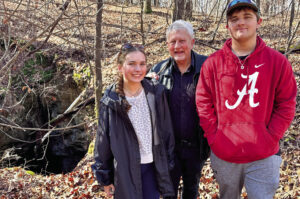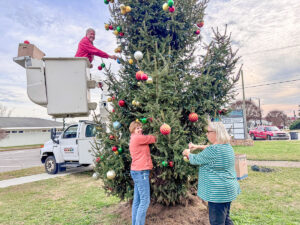Become garden savvy with these springtime tips
Courtesy of the Alabama Cooperative Extension System
MARCH
Fruits and nuts
• Continue strawberry and grape plantings.
• Bud apples and peaches.
• Start planting blackberries. If weather conditions prevent prompt planting, heel the plants in by placing the root system in a trench and covering the soil.
Shrubs
• Fertilize shrubs, except azaleas and camellias, according to a soil test.
• Late plantings can be made, particularly if they are container grown.
• Monitor shrubs for harmful insects.
Lawns
• Soil test and add limestone as recommended.
• Fertilize fescue lawns at 1 pound slow-release nitrogen per 1,000 square feet.
Roses
• Watch new growth for aphids.
• Begin a spray or dust program.
• Begin fertilizing.
Annuals and perennials
• Check garden centers for bedding plants such as geraniums and petunias.
Bulbs
• Plant gladiolus every 2 or 3 weeks if a long blooming season is desired.
• Plant tuberous begonias in pots.
• Plant dahlias.
Miscellaneous
• Check and repair sprayers, dusters and lawn mowers.
• Control lawn weeds with chemicals as needed. If weeds are deemed a serious problem, send a soil sample for testing, as weeds can indicate the lawn is unhealthy.
• Delay pruning of fruiting shrubs such as cotoneasters, pyracanthas and hollies until after flowering.
Vegetables
• Seeds: Plant all hardy crops recommended for January and February, such as garden peas, leafy greens and root crops.
• Transplants: Plant asparagus, onion sets and lettuce. Plant certified seed potatoes for Irish and red-skinned varieties in early March.
APRIL
Fruits and nuts
• Continue strawberry planting.
• Start spray program for all fruits.
• Plant raspberries and blackberries and continue budding apples and peaches.
Shrubs
• Prune spring flowering shrubs after flowering.
• Fertilize azaleas and camellias.
• Spray all shrubs with a fungicide as new growth begins to mature.
Lawns
• Continue planting new lawns.
• When daytime temperatures are consistently above 70 degrees, apply fire ant bait. Read the label carefully for best control.
• Start a mowing routine as spring growth begins.
• Monitor the thatch layer in bermudagrass and zoysiagrass lawns. Dethatch if thicker than 1⁄2 inch. Wait until active growth.
• Monitor for fungal disease in wet, cool weather.
• Fertilize warm-season lawns after fully green.
Roses
• Watch for insects and diseases.
• Keep old flower heads removed.
• Plant container-grown plants from nurseries or garden centers.
Annuals and perennials
• Plant early-started annuals or bedding plants from nurseries or garden centers.
• Divide mums or root cuttings.
• Dig and divide dahlias.
Bulbs
• Plant gladiolus, fancy-leaved caladiums, milk and wine lilies and ginger and gloriosa lilies.
• Apply super phosphate to bearded iris and scout for iris borer moth caterpillars.
• Avoid cutting foliage of narcissus or other bulbs until it has turned brown naturally.
Miscellaneous
• Spray camellias, hollies and others for scale insects.
• Carefully water new plantings of shrubs and trees.
• Pinch out tips of new shoots to promote more compact shrubs.
Vegetables
• Seeds: Wait until late April to plant beans, cucumbers, melons, Southern peas and squash. Plant sweet corn each week for a staggered summer harvest.
• Plant transplants of tomato, pepper, and eggplant.
• Plant sweet potato slips in late April.
MAY
Fruits and nuts
• Continue spray program.
• Keep grass from around trees and strawberries.
• Peaches and apples can still be budded.
Shrubs
• Newly-planted shrubs need extra care now and in coming weeks.
• Do not spray with horticultural oils when the temperature is above 85 degrees.
Lawns
• Start new lawns from seed.
• Call the Master Gardener Helpline at 877-252-4769 to learn more about seasonal fertilizer use and proper mowing. Over-fertilizing and over-watering lead to lawn problems.
• Wait until warm-season lawns are fully green before applying any fertilizers.
• Mow often, every five to 10 days, removing a third of the grass height at each mowing
• Apply 1 pound nitrogen per 1,000 square feet to all warm-season lawn types: bermudagrass, centipedegrass, St. Augustinegrass and zoysiagrass, or wait until after dethatching.
• Dethatch warm-season lawns if needed. Check thatch layer, as in April. Water and fertilize after dethatching, 1 pound nitrogen per 1,000 square feet.
Roses
• Spray or dust for insects and diseases.
• Fertilize monthly according to a soil test.
• Plant container-grown plants in flower.
• Prune climbing roses after the first big flush of flowering.
Annuals and perennials
• Late plantings of bedding plants still have time to produce.
• Watch for insects on day lilies.
Bulbs
• Summer bulbs started in containers may still be planted.
• Do not remove foliage from spring flowering bulbs.
• Do not let seed heads form on tulips and other spring flowering bulbs.
Miscellaneous
• Mulch new shrub plantings if not already done.
• Monitor new landscape plantings of shrubs, trees and turf. To establish healthy root systems, prevent them from drying out and water deeply.
Vegetables
• Continue plantings of all April seeds.
• Add okra and Southern pea seeds to your garden.
• Continue plantings of April transplant crops.
• Plant certified sweet potato slips.
For more information call the Master Gardener Helpline at 877-252-4769. A Master Gardener Extension volunteer is always on call.











